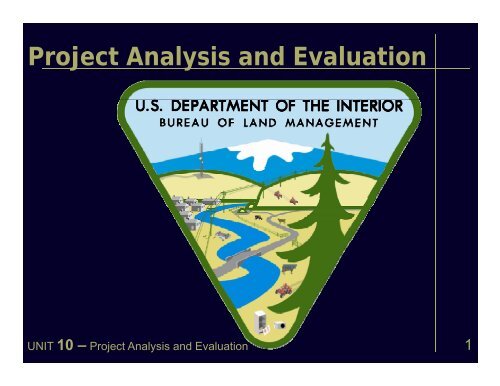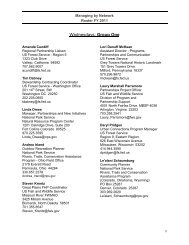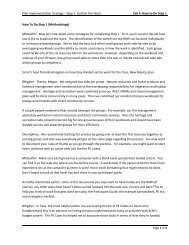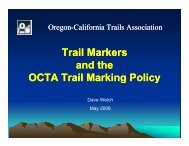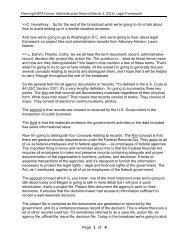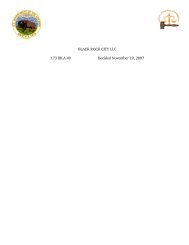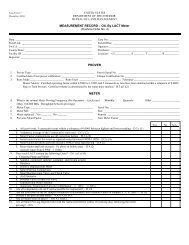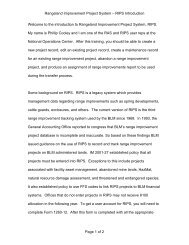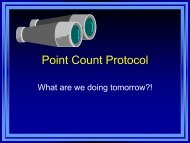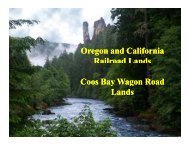Project Analysis and Evaluation - Bureau of Land Management
Project Analysis and Evaluation - Bureau of Land Management
Project Analysis and Evaluation - Bureau of Land Management
You also want an ePaper? Increase the reach of your titles
YUMPU automatically turns print PDFs into web optimized ePapers that Google loves.
<strong>Project</strong> <strong>Analysis</strong> <strong>and</strong> <strong>Evaluation</strong><br />
UNIT 10 – <strong>Project</strong> <strong>Analysis</strong> <strong>and</strong> <strong>Evaluation</strong><br />
1
Objective<br />
Provide accurate <strong>and</strong><br />
complete information to the<br />
decision maker.<br />
unit 10 – <strong>Project</strong> <strong>Analysis</strong> <strong>and</strong> <strong>Evaluation</strong><br />
2
Initial <strong>Project</strong> Considerations<br />
• What is your role<br />
• When to be scared!<br />
• <strong>Project</strong> complexity<br />
• Use third party consultants<br />
• Cost recovery<br />
• Skill set <strong>and</strong> workload<br />
• Part <strong>of</strong> a larger project<br />
3
Objective<br />
Analyze a project<br />
proposal p using the<br />
visual contrast rating<br />
system to determine<br />
the elements <strong>of</strong> a<br />
project that are<br />
inconsistent with VRM<br />
objectives <strong>and</strong><br />
recommend measures<br />
to improve the visual<br />
quality <strong>of</strong> that project<br />
unit 10 – <strong>Project</strong> <strong>Analysis</strong> <strong>and</strong> <strong>Evaluation</strong><br />
4
Contrast Rating<br />
A systematic process we use to identify,<br />
describe <strong>and</strong> analyze potential visual<br />
impacts <strong>of</strong> proposed projects <strong>and</strong><br />
activities<br />
unit 10 – <strong>Project</strong> <strong>Analysis</strong> <strong>and</strong> <strong>Evaluation</strong><br />
5
Visual Contrast Rating<br />
• Systematic process m<strong>and</strong>ated by <strong>Bureau</strong><br />
policy<br />
• Helps identify where <strong>and</strong> how the greatest<br />
visual contrasts occur in a project <strong>and</strong> how<br />
these can be mitigated<br />
• Assists <strong>Bureau</strong> personnel not formally trained<br />
in the design arts to apply basic principles <strong>of</strong><br />
design to resolve visual impacts <strong>and</strong> review<br />
analysis done by others.<br />
unit 10 – <strong>Project</strong> <strong>Analysis</strong> <strong>and</strong> <strong>Evaluation</strong><br />
6
Basic Philosophy<br />
The degree to which a development adversely<br />
affects the visual quality <strong>of</strong> a l<strong>and</strong>scape is directly<br />
related to the amount <strong>of</strong> visual contrast<br />
t<br />
between it <strong>and</strong> the existing l<strong>and</strong>scape character<br />
unit 10 – <strong>Project</strong> <strong>Analysis</strong> <strong>and</strong> <strong>Evaluation</strong><br />
7
Visual Contrast Rating System<br />
The amount <strong>of</strong> contrast is measured by<br />
separating the l<strong>and</strong>scape into major features:<br />
(l<strong>and</strong>/water, vegetation, structures)<br />
then predicting i the magnitude <strong>of</strong> contrast in<br />
each <strong>of</strong> the l<strong>and</strong>scape character elements:<br />
FORM – LINE – COLOR - TEXTURE<br />
unit 10 – <strong>Project</strong> <strong>Analysis</strong> <strong>and</strong> <strong>Evaluation</strong><br />
8
Contrast Rating System<br />
• Prototype VMS system developed in 1979<br />
9
Analytical Format<br />
L<strong>and</strong>sc cape<br />
Charac cter<br />
Elemen nts<br />
Form<br />
Line<br />
Color<br />
Texture<br />
Major Features<br />
L<strong>and</strong>/Water Vegetation Structures<br />
unit 10 – <strong>Project</strong> <strong>Analysis</strong> <strong>and</strong> <strong>Evaluation</strong><br />
10
Analytical Format<br />
• Quickly reveals elements & features that<br />
cause the greatest visual impact<br />
• A guide to methods to reduce the visual<br />
impact <strong>of</strong> a proposed project or activity<br />
• Provides basis for design that reflects <strong>and</strong><br />
responds to the setting<br />
unit 10 – <strong>Project</strong> <strong>Analysis</strong> <strong>and</strong> <strong>Evaluation</strong><br />
11
Visual Contrast Rating<br />
• Not a pass – fail exercise. We want an “A”<br />
• Every attempt is made to reduce visual impacts<br />
even if the proposed project meets VRM<br />
<strong>Management</strong> Objectives for the area<br />
unit 10 – <strong>Project</strong> <strong>Analysis</strong> <strong>and</strong> <strong>Evaluation</strong><br />
12
Steps - Contrast Rating Process<br />
1. Obtain a complete project description<br />
2. Identify VRM Objectives from RMP<br />
3. Assess project visibility - Select Key Observation<br />
point(s)<br />
4. Prepare visual representation/simulation<br />
5. Complete Contrast Rating<br />
unit 10 – <strong>Project</strong> <strong>Analysis</strong> <strong>and</strong> <strong>Evaluation</strong><br />
13
Step 1 – Obtain Detailed <strong>Project</strong> Description<br />
• Emphasize early contact with project<br />
proponent<br />
• Coach proponent on project design<br />
• Proposal must be comprehensive<br />
• Materials<br />
•Scale<br />
• Colors/Reflectivity<br />
•Lights<br />
• Temp structures/seasonal use<br />
unit 10 – <strong>Project</strong> <strong>Analysis</strong> <strong>and</strong> <strong>Evaluation</strong><br />
14
Step 2 - Identify VRM Class From RMP<br />
unit 10 – <strong>Project</strong> <strong>Analysis</strong> <strong>and</strong> <strong>Evaluation</strong><br />
15
No VRM Class Map<br />
• Follow BLM policy – H<strong>and</strong>book<br />
• Inform manager!<br />
• Inventory project area.<br />
• Find RMP emphasis for that area.<br />
• Develop range <strong>of</strong> alternatives.<br />
• Prepare contrast ratings.<br />
16
Step 3 – Assess <strong>Project</strong> Visibility<br />
• Viewshed <strong>Analysis</strong><br />
• Section/Line <strong>of</strong> sight analysis<br />
• Site <strong>and</strong> area reconnaissance<br />
Key Observation Point – A critical viewpoint or place from<br />
which we analyze the visual impact <strong>of</strong> a Proposed <strong>Project</strong><br />
unit 10 – <strong>Project</strong> <strong>Analysis</strong> <strong>and</strong> <strong>Evaluation</strong><br />
17
Typical <strong>Project</strong> KOPs<br />
• Scenic Overlooks, Rivers & Roads<br />
• Important Vantage Points<br />
• Places from which a proposed project is seen by large<br />
numbers <strong>of</strong> viewers (representative) or critical viewers<br />
• Views From Communities or Subdivisions<br />
• Point where view <strong>of</strong> proposed project is most<br />
revealing (careful to avoid bias in analysis)<br />
unit 10 – <strong>Project</strong> <strong>Analysis</strong> <strong>and</strong> <strong>Evaluation</strong><br />
18
KOP Considerations<br />
• RMP direction, IDT input<br />
• Distance<br />
• Angle <strong>of</strong> observation<br />
• # <strong>of</strong> Viewers<br />
• Length <strong>of</strong> time project is in view<br />
• Relative project size<br />
• Season <strong>of</strong> use<br />
• Light conditions & other factors as appropriate<br />
unit 10 – <strong>Project</strong> <strong>Analysis</strong> <strong>and</strong> <strong>Evaluation</strong><br />
19
Rock Quarry – low angle<br />
unit 10 – <strong>Project</strong> <strong>Analysis</strong> <strong>and</strong> <strong>Evaluation</strong><br />
20
Rock Quarry – high angle<br />
unit 10 – <strong>Project</strong> <strong>Analysis</strong> <strong>and</strong> <strong>Evaluation</strong><br />
21
Rock Quarry - foreground<br />
unit 10 – <strong>Project</strong> <strong>Analysis</strong> <strong>and</strong> <strong>Evaluation</strong><br />
22
Rock Quarry - Background<br />
unit 10 – <strong>Project</strong> <strong>Analysis</strong> <strong>and</strong> <strong>Evaluation</strong><br />
23
Seasonal considerations<br />
unit 10 – <strong>Project</strong> <strong>Analysis</strong> <strong>and</strong> <strong>Evaluation</strong><br />
24
Step 4 – Prepare Visual Simulations<br />
• Helps to underst<strong>and</strong> the project<br />
• Helps to underst<strong>and</strong> the visual impact<br />
• Great way to illustrate impacts in EA<br />
• Seeing an image <strong>of</strong> the project is much more<br />
powerful than trying to imagine it<br />
• Helps eliminate bias<br />
• Allows all team members to see the project<br />
the same<br />
unit 10 – <strong>Project</strong> <strong>Analysis</strong> <strong>and</strong> <strong>Evaluation</strong><br />
25
Penstock/pump station site<br />
unit 10 – <strong>Project</strong> <strong>Analysis</strong> <strong>and</strong> <strong>Evaluation</strong><br />
26
Quick paintshop line drawing<br />
unit 10 – <strong>Project</strong> <strong>Analysis</strong> <strong>and</strong> <strong>Evaluation</strong><br />
27
Built project<br />
unit 10 – <strong>Project</strong> <strong>Analysis</strong> <strong>and</strong> <strong>Evaluation</strong><br />
28
Color option/mitigation<br />
unit 10 – <strong>Project</strong> <strong>Analysis</strong> <strong>and</strong> <strong>Evaluation</strong><br />
29
Reduce edge contrast<br />
Old well pad.<br />
30
Reduce edge contrast<br />
Old well pad with edges blended.<br />
31
Step 5 – Complete Contrast Rating<br />
• See <strong>Bureau</strong> Manual H<strong>and</strong>book H-8431-1<br />
(Note the Illustrations <strong>and</strong> appendices)<br />
– Tips/techniques:<br />
• Use IDT <strong>and</strong> mentor in field<br />
• If possible, take a recon trip first to familiarize<br />
yourself with directions, setting <strong>and</strong> light<br />
conditions at different times <strong>of</strong> day<br />
• GPS <strong>and</strong> photograph the locations you conduct<br />
the analysis from<br />
• Cover elements on worksheet – can use different<br />
format or record observations on tape recorder<br />
unit 10 – <strong>Project</strong> <strong>Analysis</strong> <strong>and</strong> <strong>Evaluation</strong><br />
33
Let’s Walk Through an Example<br />
• What is the first step in the process<br />
unit 10 – <strong>Project</strong> <strong>Analysis</strong> <strong>and</strong> <strong>Evaluation</strong><br />
35
Obtain Complete <strong>Project</strong> Description<br />
unit 10 – <strong>Project</strong> <strong>Analysis</strong> <strong>and</strong> <strong>Evaluation</strong><br />
36
Review established VRM objectives<br />
unit 10 – <strong>Project</strong> <strong>Analysis</strong> <strong>and</strong> <strong>Evaluation</strong><br />
37
Select KOP(s)<br />
unit 10 – <strong>Project</strong> <strong>Analysis</strong> <strong>and</strong> <strong>Evaluation</strong><br />
38
Prepare Visual Simulation<br />
• Photo <strong>of</strong> proposed project site<br />
unit 10 – <strong>Project</strong> <strong>Analysis</strong> <strong>and</strong> <strong>Evaluation</strong><br />
39
Simulation <strong>of</strong> Proposed <strong>Project</strong><br />
unit 10 – <strong>Project</strong> <strong>Analysis</strong> <strong>and</strong> <strong>Evaluation</strong><br />
40
Complete Contrast Rating<br />
• Section A <strong>of</strong> Form 8400-4<br />
Form 8400-4<br />
(September 1985) UNITED STATES<br />
DEPARTMENT OF THE INTERIOR<br />
BUREAU OF LAND MANAGEMENT<br />
Date: Feb 24, 2004<br />
District: N/A<br />
Resource Area: L<strong>and</strong>er<br />
VISUAL CONTRAST RATING WORKSHEET Activity: Oil & Gas<br />
1. <strong>Project</strong> Name: Well No 136<br />
2. Key Observation Point<br />
29/91 Sec 21: SESE<br />
3. VRM Class<br />
VRM Class IV<br />
SECTION A. PROJECT INFORMATION<br />
4. Location<br />
Township__29N_______<br />
Range ___91W_________<br />
Section ___21___________<br />
5. Location Sketch<br />
unit 10 – <strong>Project</strong> <strong>Analysis</strong> <strong>and</strong> <strong>Evaluation</strong><br />
41
Section B <strong>of</strong> Contrast Rating Form<br />
Characteristic L<strong>and</strong>scape Description<br />
FO ORM<br />
SECTION B. CHARACTERISTIC LANDSCAPE DESCRIPTION<br />
1. LAND/WATER 2. VEGETATION 3. STRUCTURES<br />
Gently rolling terrain,<br />
low hills<br />
Low, continuous<br />
sagebrush cover, smooth,<br />
regular pattern<br />
None noted in view<br />
toward the project from<br />
the KOP<br />
LI INE<br />
Mostly horizontal<br />
undulating lines. A<br />
horizontal l<strong>and</strong>scape<br />
Weak horizontal lines<br />
created by changes in<br />
vegetative patterns<br />
None noted in view<br />
toward the project from<br />
the KOP<br />
COLOR<br />
Light brown to buff<br />
where visible<br />
Gray-green <strong>of</strong> sagebrush<br />
is dominant, mostly<br />
continuous<br />
None noted in view<br />
toward the project from<br />
the KOP<br />
TEX-<br />
TURE<br />
Smooth, continuous<br />
Medium to slightly coarse<br />
in immediate foreground<br />
to smooth/fine in<br />
middleground<br />
d<br />
None noted in view<br />
toward the project from<br />
the KOP<br />
unit 10 – <strong>Project</strong> <strong>Analysis</strong> <strong>and</strong> <strong>Evaluation</strong><br />
42
Section C <strong>of</strong> Contrast Rating Form<br />
Proposed Activity Description<br />
FORM<br />
LINE<br />
COLOR<br />
TEX-<br />
TURE<br />
SECTION C. PROPOSED ACTIVITY DESCRIPTION<br />
1. LAND/WATER 2. VEGETATION 3. STRUCTURES<br />
Flat, leveled pad(s), Veg removed from pad, Cylindrical tanks, rectangular<br />
curvilinear road(s), road(s), reclaimed veg<br />
separator unit.<br />
narrow, linear form low, sparce<br />
A dominant visual<br />
element<br />
Where seen, pad<br />
appears as a distinct<br />
horizontal line, same<br />
with roads<br />
Light brown to buffcolored<br />
pad(s) & road<br />
surfaces.<br />
Smooth texture on<br />
pad(s) & road(s)<br />
Sharper line(s) where<br />
veg removed<br />
Tan to light buff most<br />
<strong>of</strong> year, light green in<br />
spring.<br />
Smooth where reestablished<br />
(grasses)<br />
Sage may re-establish<br />
in 20 years<br />
Structures have vertical<br />
alignment <strong>and</strong> are visible<br />
Carlsbad Canyon<br />
contrasts with darker<br />
gray <strong>of</strong> sagebrush<br />
Smooth texture <strong>of</strong><br />
facilities a dominant<br />
feature <strong>of</strong> project<br />
unit 10 – <strong>Project</strong> <strong>Analysis</strong> <strong>and</strong> <strong>Evaluation</strong><br />
43
Section D <strong>of</strong> Contrast Rating form<br />
SECTION D. CONTRAST RATING SHORT TERM X LONG TERM<br />
1.Degree<br />
FEATURES<br />
<strong>of</strong><br />
L<strong>and</strong>/Water Body Vegetation Structures 2. Does <strong>Project</strong> Design meet visual<br />
Contrast<br />
resource management objectives<br />
Yes __X_ No ____ (explain on reverse)<br />
3. Additional mitigating measures<br />
recommended.<br />
Yes __X_ No ____ (explain on reverse)<br />
TS<br />
ELEMEN<br />
Strong<br />
Moderate<br />
Weak<br />
None<br />
Form X X X<br />
Line X X X<br />
Color X X X<br />
Texture X X X<br />
Strong<br />
Moderate<br />
Weak<br />
None<br />
Strong<br />
Moderate<br />
Weak<br />
None<br />
Evaluator’s Names Date:<br />
Cimarron Chacon 7/16/04<br />
Allysia Angus<br />
Consider mitigation measures as you id contrast:<br />
• What are strong elements in the project setting<br />
• What are strong elements in the project<br />
• What can you borrow from the setting<br />
• What can you change in the setting<br />
• What can you change in the project:<br />
• make it fit in setting (color, form, texture, scale…)<br />
• move it<br />
44
Section D – Reverse Side <strong>of</strong> form<br />
Comments from Item 2.<br />
SECTION D. (Continued)<br />
The line created by the clearing for the road <strong>and</strong> drill pad creates a contrast that will<br />
attract attention. The installation <strong>of</strong> storage tanks <strong>and</strong> the separator unit will introduce<br />
vertical-aligned forms that contrast with the characteristic l<strong>and</strong>scape. The structures will<br />
have a smooth texture as opposed to the coarse texture <strong>of</strong> surrounding sagebrush. The<br />
facilities introduce vertical lines which will contrast with the predominately horizontal<br />
l<strong>and</strong>scape. The color <strong>of</strong> the tanks as proposed will contrast with the darker color <strong>of</strong> the<br />
dominant sagebrush.<br />
unit 10 – <strong>Project</strong> <strong>Analysis</strong> <strong>and</strong> <strong>Evaluation</strong><br />
45
Contrast Rating form – Mitigating<br />
Measures<br />
Additional Mitigating Measures (See item 3)<br />
1. As per agreement with company representatives, relocate drill pad 250<br />
feet northwest behind/between low stabilized s<strong>and</strong> dunes.<br />
2. Relocate access road behind/between stabilized dunes<br />
3. Use low pr<strong>of</strong>ile tanks a maximum <strong>of</strong> 12 feet high rather than the st<strong>and</strong>ard<br />
18 foot tanks<br />
4. Paint facilities a color compatible with sagebrush, the dominant veg<br />
species in the area<br />
unit 10 – <strong>Project</strong> <strong>Analysis</strong> <strong>and</strong> <strong>Evaluation</strong><br />
46
Simulation <strong>of</strong> <strong>Project</strong> with Mitigation<br />
unit 10 – <strong>Project</strong> <strong>Analysis</strong> <strong>and</strong> <strong>Evaluation</strong><br />
47
Review <strong>of</strong> VRM Class Objectives<br />
Class I<br />
• Preserve the existing character <strong>of</strong> the<br />
l<strong>and</strong>scape. Manage for natural ecological<br />
changes<br />
• Change Allowed: Very Low<br />
• Activities must not attract attention<br />
unit 10 – <strong>Project</strong> <strong>Analysis</strong> <strong>and</strong> <strong>Evaluation</strong><br />
48
Review <strong>of</strong> VRM Class Objectives<br />
Class II<br />
• Retain the existing character <strong>of</strong> the<br />
l<strong>and</strong>scape<br />
•Change allowed: Low<br />
• Activities may be visible but should not<br />
attract attention <strong>of</strong> the casual observer<br />
unit 10 – <strong>Project</strong> <strong>Analysis</strong> <strong>and</strong> <strong>Evaluation</strong><br />
49
Review <strong>of</strong> VRM Class Objectives<br />
• Class III<br />
• Partially retain the existing character <strong>of</strong><br />
the l<strong>and</strong>scape<br />
• Change allowed: Moderate<br />
• Activities may attract attention but should<br />
not dominate theview<strong>of</strong>thecasual<br />
observer<br />
unit 10 – <strong>Project</strong> <strong>Analysis</strong> <strong>and</strong> <strong>Evaluation</strong><br />
50
Review <strong>of</strong> VRM Class Objectives<br />
Class IV<br />
• Provide for management activities which<br />
require major modification <strong>of</strong> the existing<br />
character <strong>of</strong> the l<strong>and</strong>scape<br />
• Change allowed: High<br />
• Activities may attract attention, may<br />
dominate the view, but are still mitigated<br />
unit 10 – <strong>Project</strong> <strong>Analysis</strong> <strong>and</strong> <strong>Evaluation</strong><br />
51
What next<br />
• Report prepared p for project record.<br />
• Discuss with project team <strong>and</strong> manager.<br />
• Information available for NEPA, may<br />
influence range <strong>of</strong> alternatives.<br />
• Information available for public<br />
<strong>and</strong> others.<br />
52


